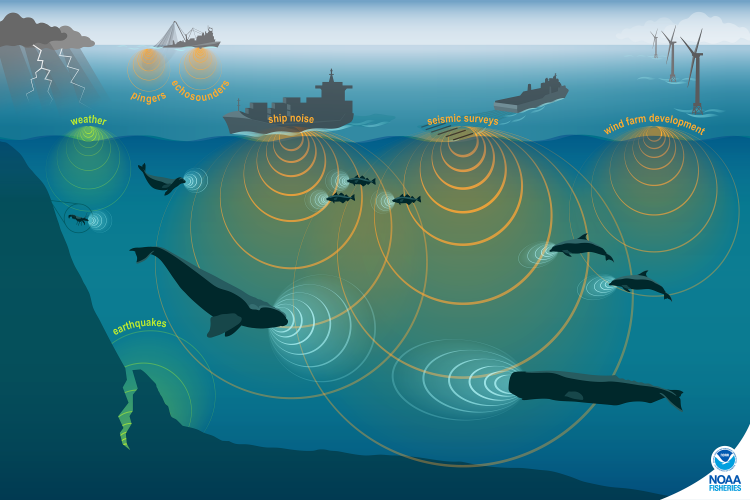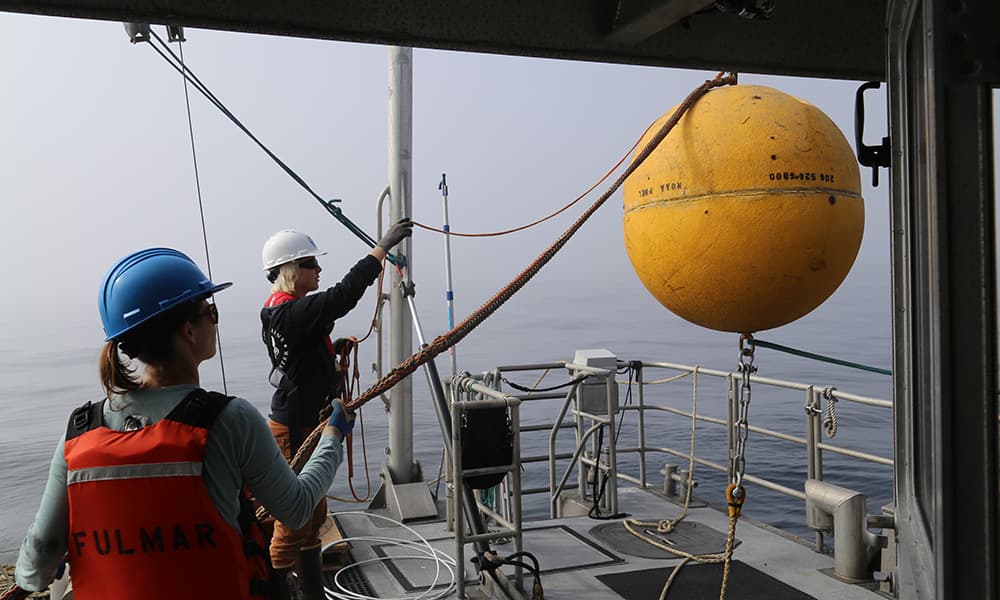Ocean Noise

The world of whales is a world of sound. Hearing is the dominant sense for whales, as vision is for humans. Through clicks, songs, and echolocation, they communicate with each other, visualize and navigate their underwater world, locate food, and maintain social groupings. They rely on hearing as their primary sense for carrying out most basic life functions. But human-generated noise in the ocean, including off the California coast, has significantly increased over the past 60 years. Ships are the primary generators of artificial ocean noise. An increase in ship speed and size results in increases in low-frequency ambient noise (McKenna 2013). Vessel noise has been linked to both short- and long-term impacts on marine mammals. Noise generated by vessels and other human activities can alter natural behaviors, disrupt activities, and obstruct communication needed to find mates, evade predators, and care for young. It can also cause temporary and permanent hearing loss and physical injury, contribute to stress (Rolland et al. 2012), and cumulatively decrease whales' abilities to sustain their overall health (Aguilar de Soto et al., 2016).
The amount of noise-producing human activities offshore and close to shore has been increasing steadily over the past 100 years, which is only a few generations of many long-lived marine species, such as large whales. Researchers found a fourfold growth in worldwide shipping traffic between 1992 and 2012 using satellite altimetry to estimate traffic density (Tournadre 2014). Significant increases were detected in most ocean areas (e.g., a two- to three-fold growth in traffic in the northern Pacific). (Moore 2019).
Sources of underwater noise include large commercial shipping traffic, smaller recreational and commercial vessels, pile drivers and dredging used in marine construction, air guns and other seismic equipment used in oil and mineral exploration and extraction, sonar and other active acoustic tools used in military and non-military activities.

Acoustic Soundscape Monitoring
Cordell Bank and Greater Farallones national marine sanctuaries initiated a program to characterize the sanctuaries' soundscape. This was done in order to better understand the acoustic impacts in support of NOAA's Ocean Noise Strategy, and in response to recommendations from the sanctuary advisory councils' addressing acoustic concerns, In 2015, sanctuary staff, in partnership with NOAA's Pacific Marine Environmental Laboratory, deployed a Noise Reference Station. The mooring and acoustic recording equipment are situated on the southern border of Cordell Bank National Marine Sanctuary adjacent to Greater Farallones National Marine Sanctuary. The acoustic equipment records underwater ambient sound in the two sanctuaries, including the traffic separation scheme's northern and western lanes. These data have allowed scientists to create a local low-frequency soundscape profile, identifying the significant sources and intensity of noise and its variability. Characterizing the soundscape, including biological and anthropogenic noise, is an essential first step towards understanding the impact that sound has on our sanctuaries' living resources.
Noise Reference Stations
The noise reference station (NRS) instruments record underwater sound for two years, after which the buoy is recovered, the data downloaded and analyzed, and the buoy redeployed. The NRS will continue to record sound in the two sanctuaries, which will allow for documenting how the soundscape varies over time. Scientists will also compare the data to that of other NRS sites around the country. Long-term soundscape monitoring will allow scientists to investigate finer scale questions about the overlap of human-made and biological sounds, such as ships and whales. Ultimately, the goal is to understand how the animals in the sanctuaries are affected by ambient noise. Funding was provided by the International Fund for Animal Welfare, Pacific Marine Environmental Lab, and Cordell Bank National Marine Sanctuary. Watch this short video and article highlighting this project.
Vessel Speed Reduction -Slower Ships are Quieter Ships
Another benefit of the vessel speed reduction program of Greater Farallones and Cordell Bank national marine sanctuaries is noise pollution reduction. Noise pollution from commercial shipping substantially contributes to noise in the ocean (Southhall 2018). At slow speeds, the engines of large ships emit less noise (Southhall 2017). A study done in Channel Islands National Marine Sanctuary measured the noise reduction from ships participating in the vessel speed reduction program and found that faster vessels are typically louder (McKenna 2013).

